The 10 Best Cantonese Learning Apps in 2025

Written by
Ernest Bio Bogore

Reviewed by
Ibrahim Litinine
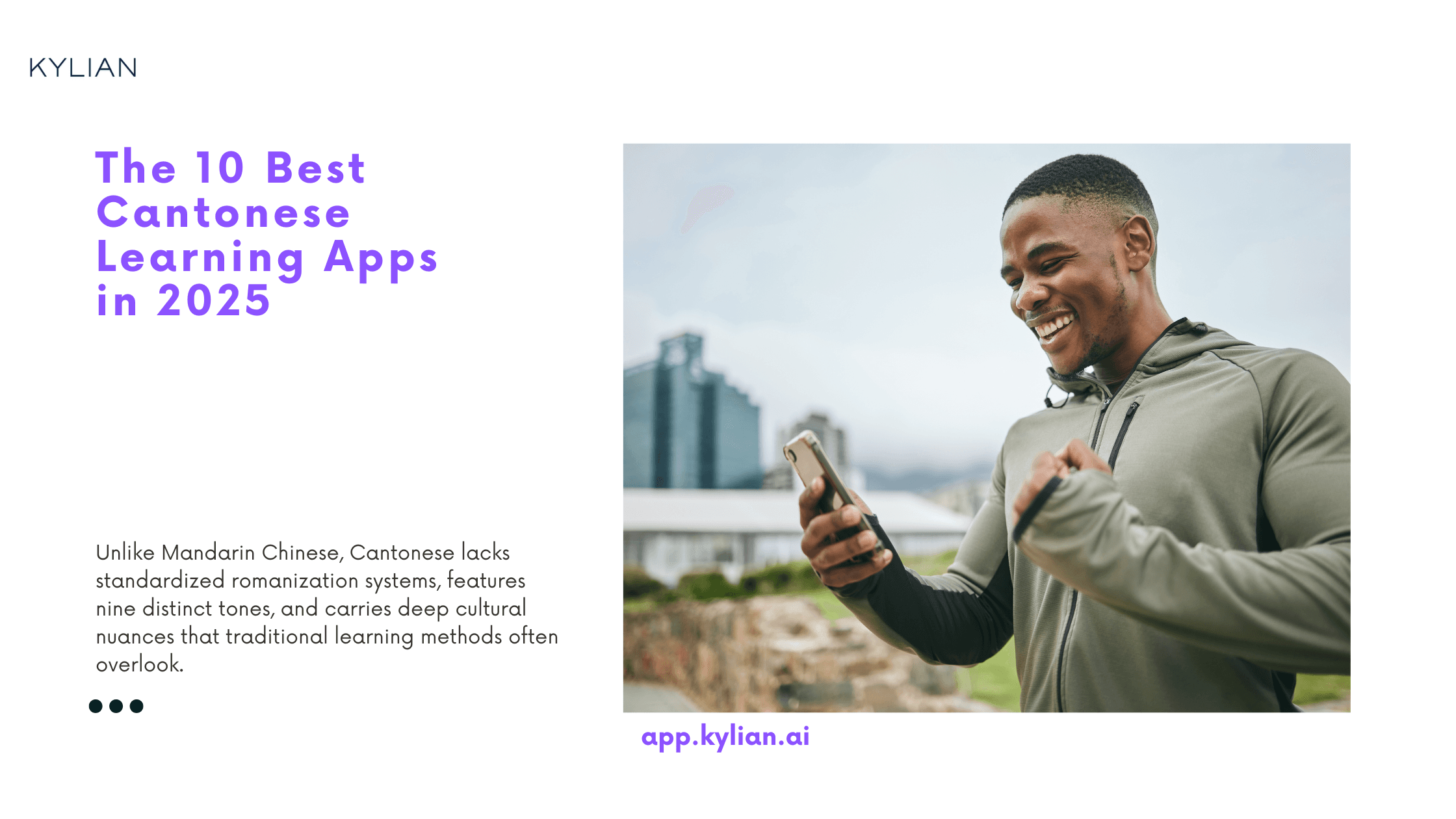
Learning Cantonese presents unique challenges that most language apps fail to address effectively. Unlike Mandarin Chinese, Cantonese lacks standardized romanization systems, features nine distinct tones, and carries deep cultural nuances that traditional learning methods often overlook. The apps flooding the market today either oversimplify these complexities or ignore them entirely, leaving learners frustrated and unprepared for real-world conversations.
This analysis cuts through the marketing noise to evaluate ten Cantonese learning applications based on their actual effectiveness, pedagogical approach, and value proposition. Each app has been assessed for its handling of tonal complexity, cultural context integration, and practical conversation skills development—the three pillars that determine whether you'll actually achieve functional Cantonese proficiency.
The evaluation criteria prioritize measurable learning outcomes over gamification gimmicks, focusing on apps that recognize Cantonese as a distinct language requiring specialized teaching methodologies rather than a simplified version of Mandarin.
Quick Comparison Overview
Before diving into detailed analysis, here's how these ten applications stack up across key metrics:
Audio-Focused Learning:
- Pimsleur: $20/month, 7-day trial
- Glossika: $16.99/month, 7-day trial
- Mango Languages: $7.99/month, 14-day trial
Vocabulary and Character Recognition:
- Memrise: $8.49/month, 14-day trial
- Drops: Free (5 min/day), $13/month unlimited
- Clozemaster: Free version, $8/month premium
Conversation Practice:
- HelloTalk: Free version, $12.99/month premium
- One-on-one tutoring platforms: Starting at $10/lesson
Comprehensive Learning:
- LingQ: $12.99/month, 7-day trial
- CantoneseClass101: $4-13.73/month, 7-day trial
1. Pimsleur: Audio-First Methodology
Best For: Developing authentic pronunciation and listening comprehension Pricing: $20/month single language, $21/month all languages Platform Availability: iOS, Android, Web Rating: 4.7/5
Pimsleur's strength lies in its scientifically-backed spaced repetition system and exclusive focus on audio learning. The method forces learners to process Cantonese sounds without visual crutches, building genuine listening skills that most apps neglect.
The program structure follows a graduated interval recall system where learners encounter new vocabulary at calculated intervals—5 seconds, 25 seconds, 2 minutes, 10 minutes, and several hours later. This approach particularly benefits Cantonese learners who must distinguish between subtle tonal variations that carry meaning.
However, Pimsleur's limitation becomes apparent in its beginner-only scope. The program offers no intermediate or advanced content, making it unsuitable for long-term language development. Additionally, the complete absence of written characters means learners cannot develop reading skills, severely limiting their ability to engage with Cantonese media or literature.
Advantages:
- Native speaker audio quality with clear tonal distinctions
- Hands-free learning compatible with commuting or exercise
- Scientifically proven spaced repetition methodology
- Focus on practical conversation patterns
Limitations:
- No progression beyond elementary level
- Zero reading or writing instruction
- Slow pacing may frustrate motivated learners
- No cultural context or regional variations
2. Mango Languages: Structured Conversational Learning
Best For: Time-constrained learners seeking systematic vocabulary building Pricing: $7.99/month single language, $17.99/month all languages Platform Availability: iOS, Android, Web Rating: 4.8/5
Mango Languages differentiates itself through color-coded grammar explanations and systematic conversation breakdowns. Each lesson dissects dialogues into component parts, explaining grammatical structures that other apps leave mysterious.
The voice recognition technology attempts to provide pronunciation feedback, though its effectiveness varies significantly. The system struggles with Cantonese's tonal complexity, often accepting imprecise pronunciations that would confuse native speakers.
The modular lesson structure allows learners to focus on specific vocabulary themes—family relationships, business interactions, or daily activities—without following a rigid sequence. This flexibility particularly benefits learners with specific goals or time constraints.
Advantages:
- Grammar explanations integrated into practical contexts
- Flexible lesson selection based on learner interests
- Color-coded visual learning aids
- Cultural notes accompanying vocabulary
Limitations:
- Insufficient content for advanced learners
- Voice recognition technology lacks tonal accuracy
- Limited speaking practice opportunities
- No character writing instruction
3. Memrise: Video-Enhanced Vocabulary Acquisition
Best For: Beginners building foundational vocabulary and character recognition Pricing: Free basic access, $8.49/month premium Platform Availability: iOS, Android, Web Rating: 4.5/5
Memrise's integration of user-generated content with professional video clips creates a unique learning environment. Native speakers demonstrate vocabulary in natural contexts, providing cultural insights that textbook-style apps cannot match.
The spaced repetition algorithm adapts to individual learning patterns, presenting challenging vocabulary more frequently while spacing out mastered words. This personalization proves particularly valuable for Cantonese learners who must memorize both pronunciation and character forms for each word.
The "Learn with Locals" feature showcases regional variations and colloquial expressions, addressing Cantonese's significant dialectical differences between Hong Kong, Guangzhou, and overseas communities.
Advantages:
- Authentic video content from native speakers
- Adaptive spaced repetition system
- Character recognition integrated with pronunciation
- Regional dialect exposure
Limitations:
- Limited conversation practice opportunities
- Inconsistent content quality in user-generated sections
- No systematic grammar instruction
- Gamification elements may distract from serious learning
4. Drops: Visual Vocabulary Learning
Best For: Visual learners expanding topic-specific vocabulary Pricing: Free (5 minutes daily), $13/month unlimited access Platform Availability: iOS, Android, Web Rating: 4.55/5
Drops transforms vocabulary acquisition into visual association games, using illustrations rather than translations to convey meaning. This approach potentially builds stronger mental connections between concepts and Cantonese expressions.
The five-minute daily limit for free users creates urgency that may enhance focus, though it frustrates learners seeking longer study sessions. The restriction reflects behavioral psychology research suggesting shorter, consistent practice outperforms marathon sessions.
The app excels in specialized vocabulary categories—medical terms, business vocabulary, or cooking ingredients—areas where traditional courses often lack depth. However, the absence of sentence context means learners struggle to use these words appropriately in conversation.
Advantages:
- Visual learning reduces translation dependency
- Extensive vocabulary across specialized topics
- Gamified elements maintain engagement
- Spaced repetition for long-term retention
Limitations:
- No conversational context for vocabulary
- Beginner-level content only
- Limited pronunciation practice
- Time restrictions may impede serious learners
5. Clozemaster: Context-Based Learning
Best For: Intermediate learners seeking contextual vocabulary expansion Pricing: Free basic version, $8/month premium Platform Availability: iOS, Android, Web Rating: 4.7/5
Clozemaster addresses a critical gap in language learning by presenting vocabulary within sentence contexts. The fill-in-the-blank methodology forces learners to understand grammatical relationships and word usage patterns rather than memorizing isolated terms.
The platform's strength lies in its massive sentence database drawn from real-world sources. Learners encounter authentic language usage patterns that reflect how Cantonese speakers actually communicate, not artificial textbook constructions.
However, the repetitive exercise format becomes monotonous, and the lack of audio feedback means learners cannot verify their pronunciation. The platform works best as a supplementary tool rather than a primary learning method.
Advantages:
- Authentic sentence contexts for vocabulary
- Large database of real-world examples
- Focus on practical, everyday expressions
- Suitable for intermediate-level learners
Limitations:
- Repetitive exercise format
- No pronunciation feedback
- Limited grammar explanations
- Minimal cultural context
6. LingQ: Content-Based Language Learning
Best For: Advanced learners engaging with authentic Cantonese media Pricing: Free basic access, $12.99/month premium Platform Availability: iOS, Android, Web Rating: 4.7/5
LingQ revolutionizes language learning by enabling learners to import any Cantonese content—news articles, song lyrics, or social media posts—and transform it into interactive lessons. This approach provides unlimited, personalized learning material that reflects learners' actual interests.
The click-to-translate functionality builds vocabulary organically as learners encounter new words in meaningful contexts. The system tracks encountered vocabulary and schedules review sessions based on individual retention patterns.
The platform particularly benefits learners interested in specific Cantonese content areas—Hong Kong cinema, Cantonese pop music, or regional news—allowing them to develop specialized vocabulary while engaging with material they genuinely enjoy.
Advantages:
- Unlimited content import from any source
- Interest-based personalized learning
- Vocabulary tracking across different contexts
- Suitable for various proficiency levels
Limitations:
- Requires self-direction and motivation
- No structured curriculum or progression
- Limited speaking practice opportunities
- Overwhelming content options may confuse beginners
7. HelloTalk: Native Speaker Exchange
Best For: Conversation practice with native Cantonese speakers Pricing: Free basic features, $12.99/month premium Platform Availability: iOS, Android, Web Rating: 4.2/5
HelloTalk creates authentic language exchange opportunities by connecting learners with native Cantonese speakers seeking to practice other languages. This reciprocal arrangement provides motivation for both parties and creates genuine communication scenarios.
The built-in translation and correction tools enable learners to communicate beyond their current proficiency level while receiving immediate feedback from native speakers. Voice messages and video calls add dimensions that text-based apps cannot provide.
However, the platform's effectiveness depends entirely on finding compatible conversation partners. Cultural differences, time zone conflicts, and varying commitment levels can create frustrating experiences for serious learners.
Advantages:
- Authentic conversation practice with native speakers
- Real-time feedback and corrections
- Cultural exchange opportunities
- Multiple communication formats (text, voice, video)
Limitations:
- Dependent on finding suitable conversation partners
- No structured curriculum or learning progression
- Potential safety concerns with stranger interactions
- Time zone differences may limit availability
8. CantoneseClass101: Structured Video Instruction
Best For: Comprehensive language instruction with cultural context Pricing: $4-13.73/month depending on plan Platform Availability: iOS, Web Rating: 4.2/5
CantoneseClass101 provides structured video lessons that break down language components systematically. The cultural context woven throughout lessons helps learners understand not just what to say, but when and why specific expressions are appropriate.
The tiered subscription model allows learners to choose their level of engagement, from basic video access to personalized instructor feedback. The premium tier includes assignment grading and direct instructor communication, bridging the gap between self-study and formal instruction.
However, the heavy reliance on English explanations may impede immersion, and the 24-month subscription commitment for premium features creates financial pressure that may not suit all learners.
Advantages:
- Comprehensive video instruction library
- Cultural context integrated throughout lessons
- Multiple subscription tiers for different needs
- Systematic progression from beginner to advanced
Limitations:
- Excessive English usage may reduce immersion
- Long-term subscription commitments required
- Somewhat disorganized course structure
- No live interaction opportunities
9. Glossika: Immersion Through Repetition
Best For: Intermediate learners developing listening fluency Pricing: $16.99/month single language, $35/month all languages Platform Availability: iOS, Android, Web Rating: 4/5
Glossika's mass sentence method exposes learners to thousands of Cantonese sentences with subtle variations, building intuitive pattern recognition rather than explicit grammar knowledge. This approach mirrors how children acquire their first language through exposure and repetition.
The AI-driven difficulty adjustment ensures learners encounter appropriately challenging content that stretches their abilities without overwhelming them. The system tracks progress across multiple dimensions—listening comprehension, pronunciation accuracy, and sentence structure recognition.
However, the method requires significant time investment and may frustrate learners who prefer understanding grammatical rules explicitly. The lack of cultural context also means learners may miss important social nuances embedded in language use.
Advantages:
- Extensive listening practice with native audio
- AI-adapted difficulty progression
- Pattern recognition development
- Suitable for building fluency quickly
Limitations:
- Minimal grammar explanations
- Challenging for complete beginners
- Limited cultural context
- Requires substantial time commitment
10. Tutoring Platforms: Personalized Professional Instruction
Best For: Learners seeking customized instruction and immediate feedback Pricing: Starting at $10/lesson Platform Availability: Various platforms available Rating: 4.8/5
Professional tutoring platforms connect learners with qualified Cantonese instructors who provide personalized curriculum, immediate feedback, and cultural insights that automated systems cannot match. The human element enables adaptive teaching that responds to individual learning styles and challenges.
The flexibility to focus on specific skills—business Cantonese, academic writing, or conversational fluency—makes tutoring particularly valuable for learners with defined goals. Regular speaking practice with qualified instructors accelerates progress significantly compared to self-study methods.
Cost considerations make tutoring less accessible than app-based learning, though the efficiency gains often justify the investment for serious learners. The requirement for scheduled sessions also demands more commitment than self-paced alternatives.
Advantages:
- Personalized instruction adapted to individual needs
- Immediate feedback and error correction
- Flexible scheduling and curriculum focus
- Cultural insights from qualified native speakers
Limitations:
- Higher cost compared to app-based alternatives
- Requires scheduled commitment
- Quality varies significantly between instructors
- Limited availability for specialized dialects
Specialized Learning Categories
Traditional Character Learning Apps
Several applications focus specifically on traditional Chinese character recognition and writing, crucial skills for reading Cantonese texts. These tools typically employ stroke order practice, radical recognition exercises, and character etymology explanations to build reading proficiency.
The most effective character learning apps integrate pronunciation with visual recognition, helping learners connect spoken Cantonese with written forms. Progressive difficulty levels gradually introduce more complex characters while reinforcing previously learned ones through spaced repetition.
Cultural Context Applications
Understanding Cantonese requires grasping cultural nuances that influence language use. Specialized apps focus on cultural context, explaining when certain expressions are appropriate, how formality levels affect word choice, and regional variations in usage patterns.
These applications often incorporate video content showing real social interactions, helping learners understand non-verbal communication elements and cultural expectations that accompany language use in different contexts.
Learn Any Language with Kylian AI
Private language lessons are expensive. Paying between 15 and 50 euros per lesson isn’t realistic for most people—especially when dozens of sessions are needed to see real progress.
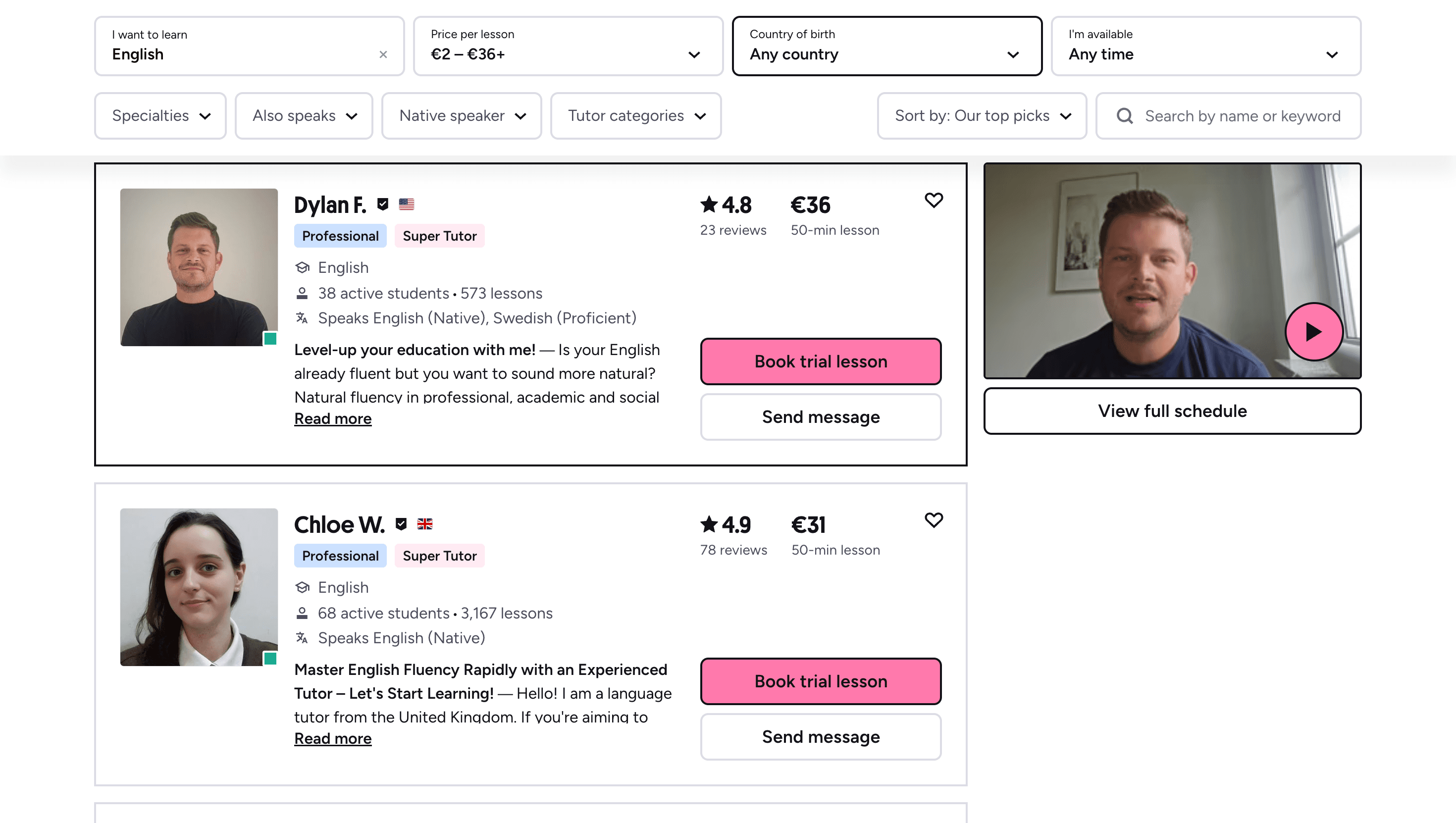
Many learners give up on language learning due to these high costs, missing out on valuable professional and personal opportunities.
That’s why we created Kylian: to make language learning accessible to everyone and help people master a foreign language without breaking the bank.
To get started, just tell Kylian which language you want to learn and what your native language is
Tired of teachers who don’t understand your specific struggles as a French speaker? Kylian’s advantage lies in its ability to teach any language using your native tongue as the foundation.
Unlike generic apps that offer the same content to everyone, Kylian explains concepts in your native language (French) and switches to the target language when necessary—perfectly adapting to your level and needs.
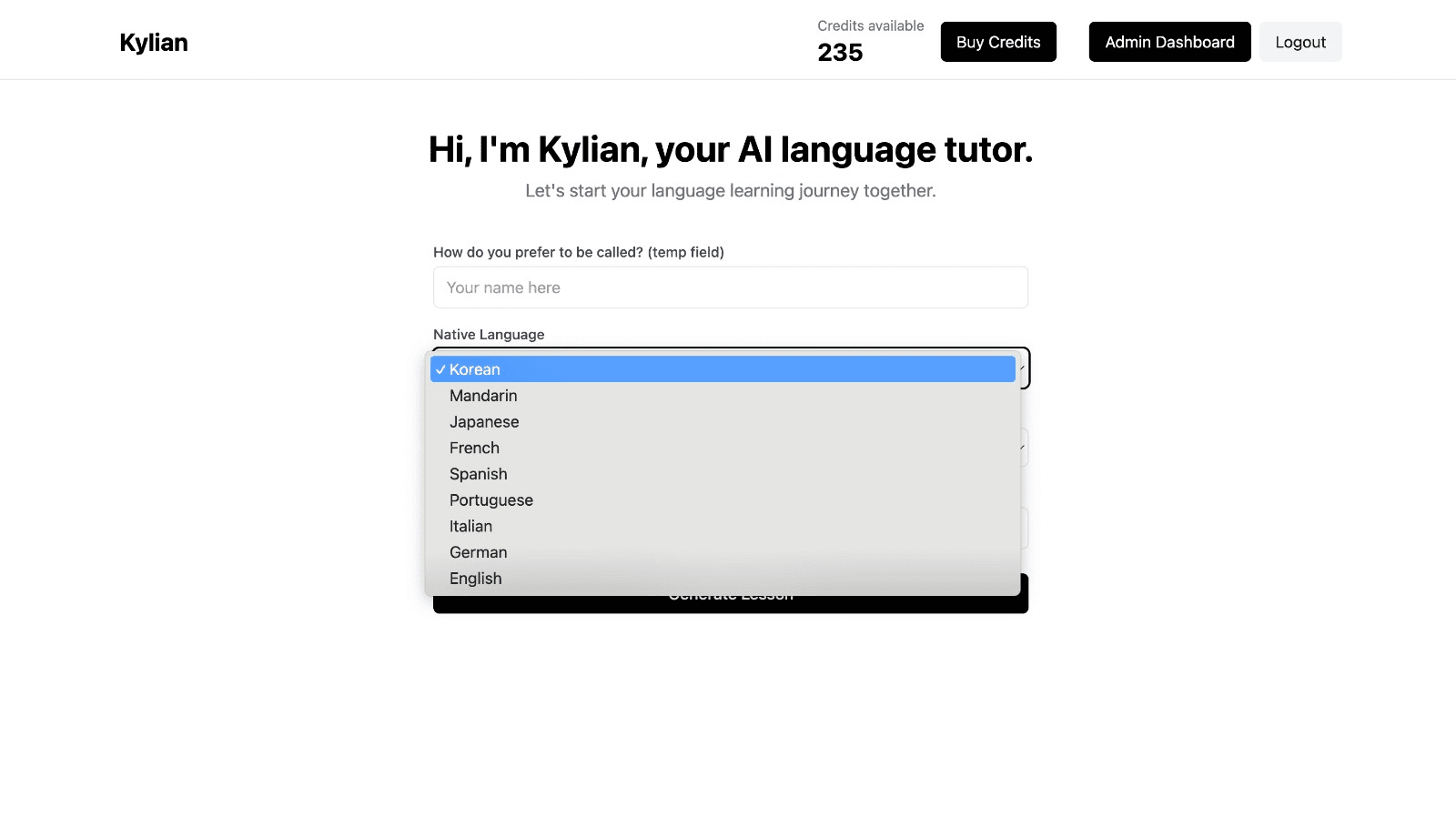
This personalization removes the frustration and confusion that are so common in traditional language learning.
Choose a specific topic you want to learn
Frustrated by language lessons that never cover exactly what you need? Kylian can teach you any aspect of a language—from pronunciation to advanced grammar—by focusing on your specific goals.
Avoid vague requests like “How can I improve my accent?” and be precise: “How do I pronounce the R like a native English speaker?” or “How do I conjugate the verb ‘to be’ in the present tense?”
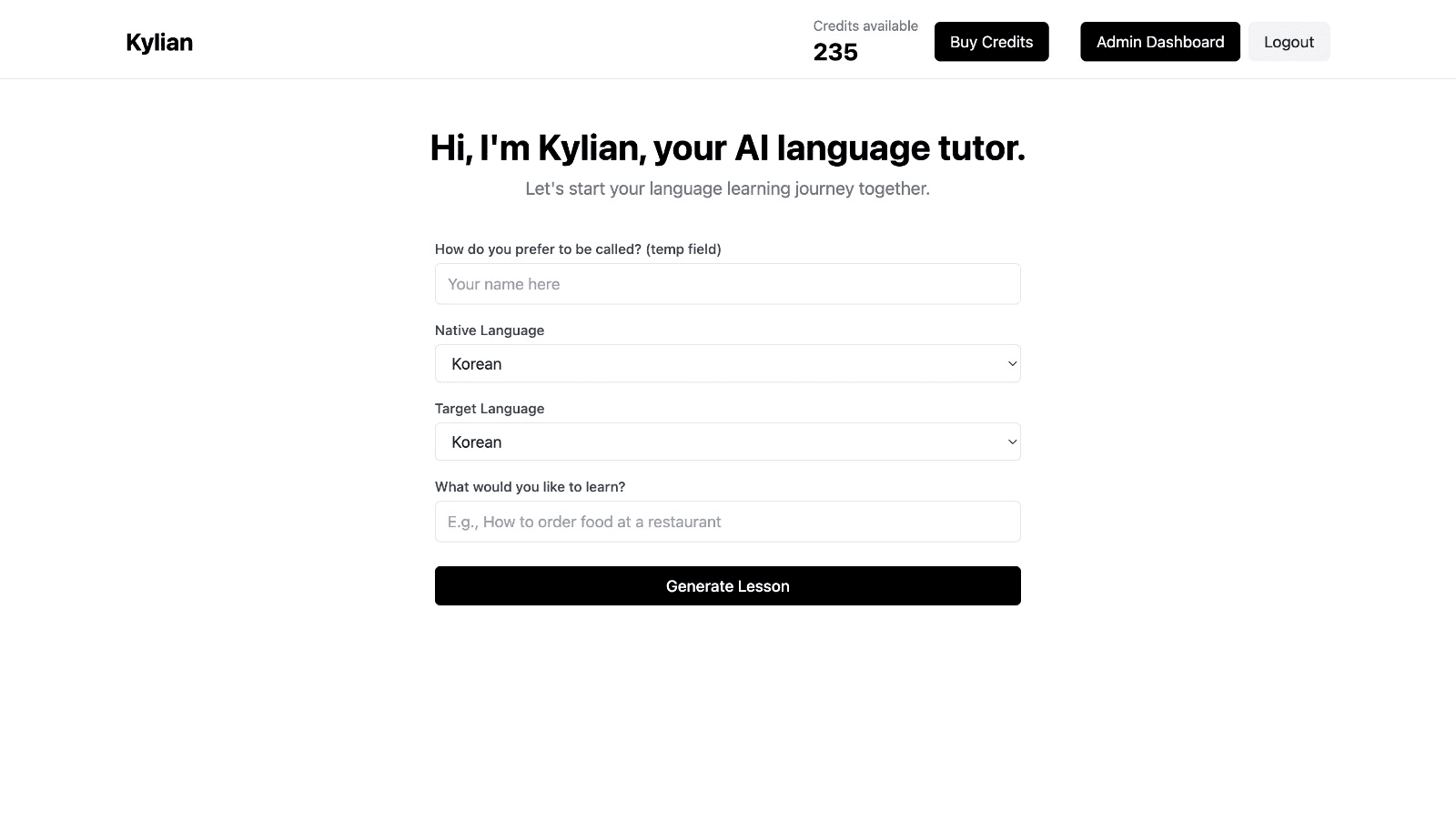
With Kylian, you’ll never again pay for irrelevant content or feel embarrassed asking “too basic” questions to a teacher. Your learning plan is entirely personalized.
Once you’ve chosen your topic, just hit the “Generate a Lesson” button, and within seconds, you’ll get a lesson designed exclusively for you.
Join the room to begin your lesson
The session feels like a one-on-one language class with a human tutor—but without the high price or time constraints.
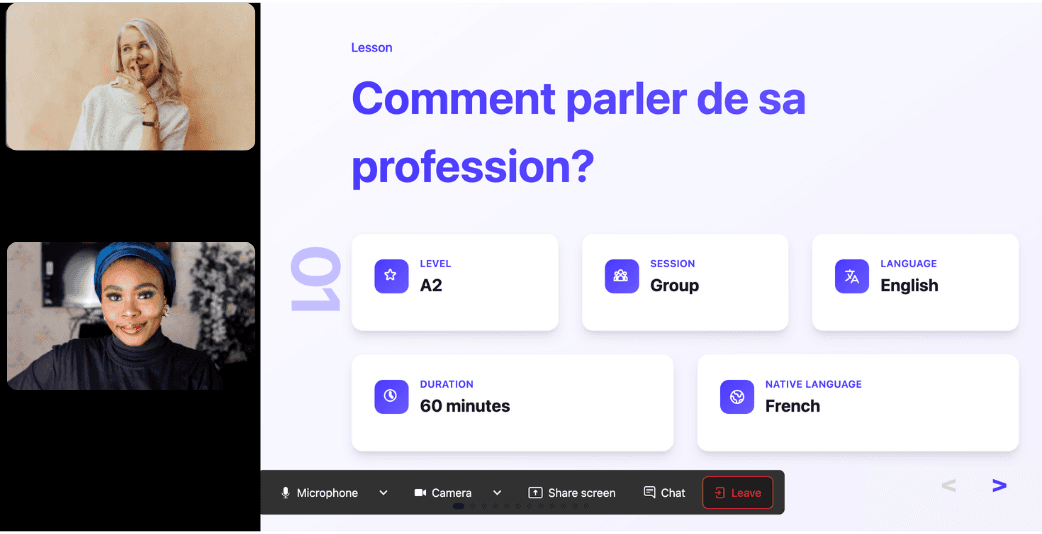
In a 25-minute lesson, Kylian teaches exactly what you need to know about your chosen topic: the nuances that textbooks never explain, key cultural differences between French and your target language, grammar rules, and much more.
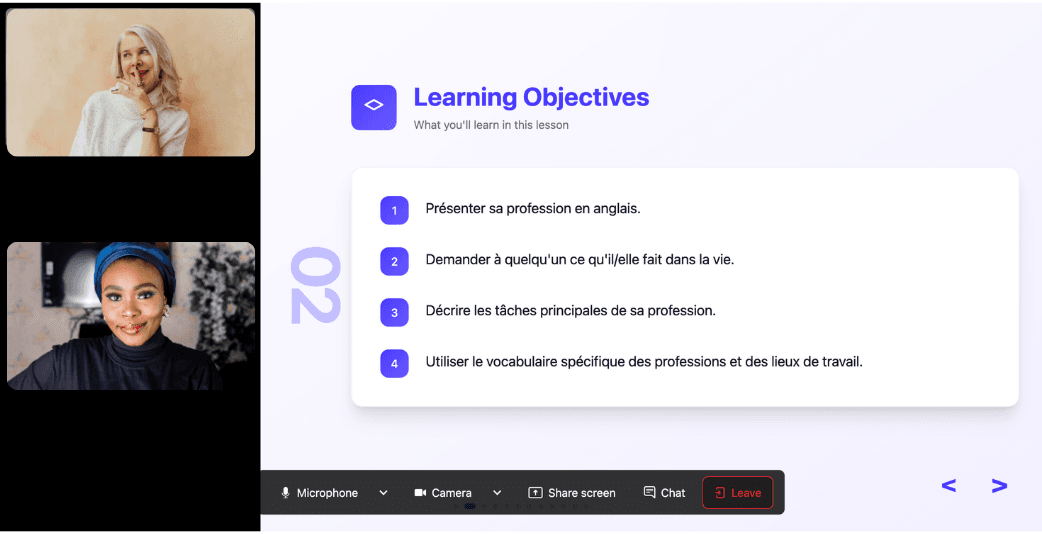
Ever felt frustrated trying to keep up with a native-speaking teacher, or embarrassed to ask for something to be repeated? With Kylian, that problem disappears. It switches intelligently between French and the target language depending on your level, helping you understand every concept at your own pace.
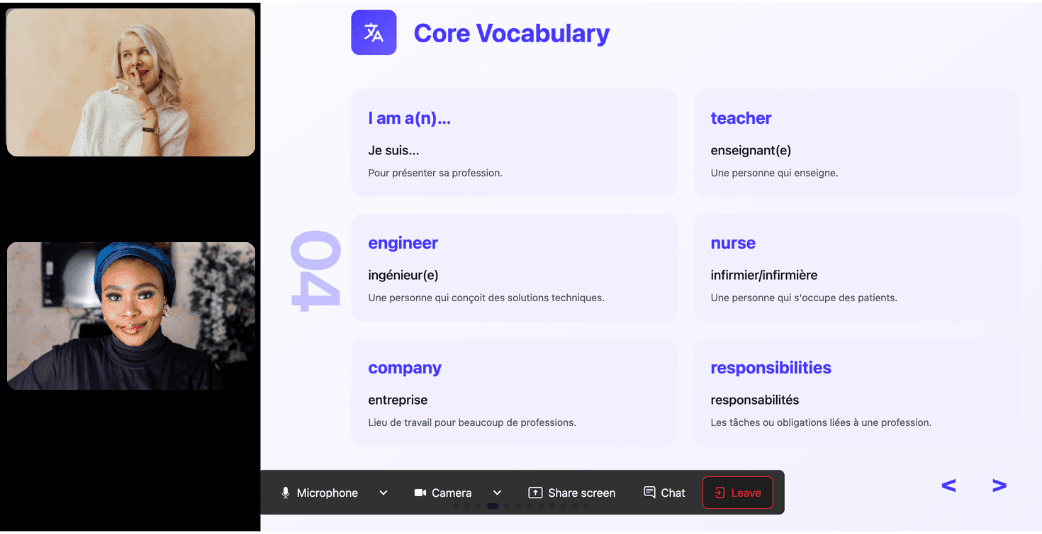
During the lesson, Kylian uses role-plays, real-life examples, and adapts to your learning style. Didn’t understand something? No problem—you can pause Kylian anytime to ask for clarification, without fear of being judged.
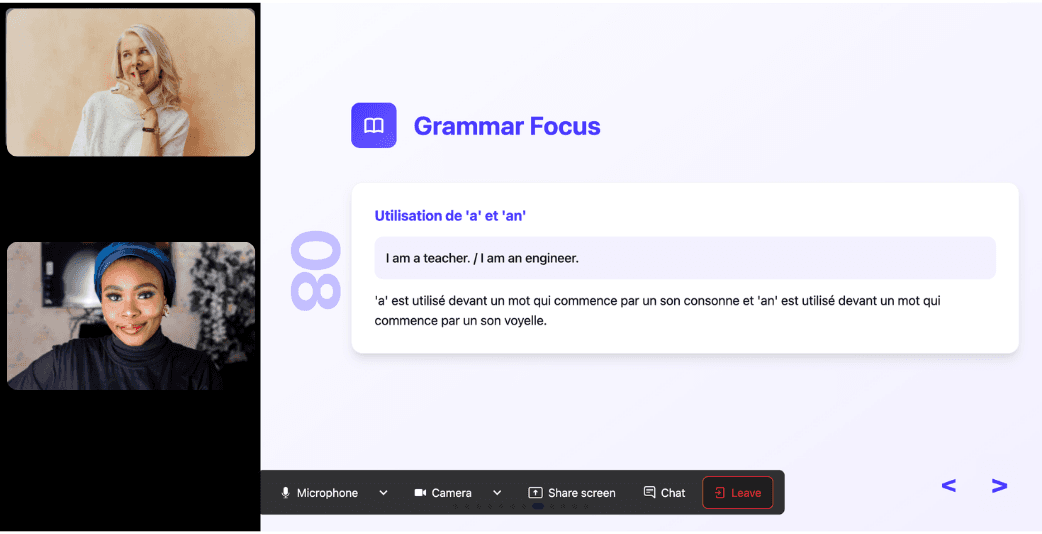
Ask all the questions you want, repeat sections if needed, and customize your learning experience in ways traditional teachers and generic apps simply can’t match.
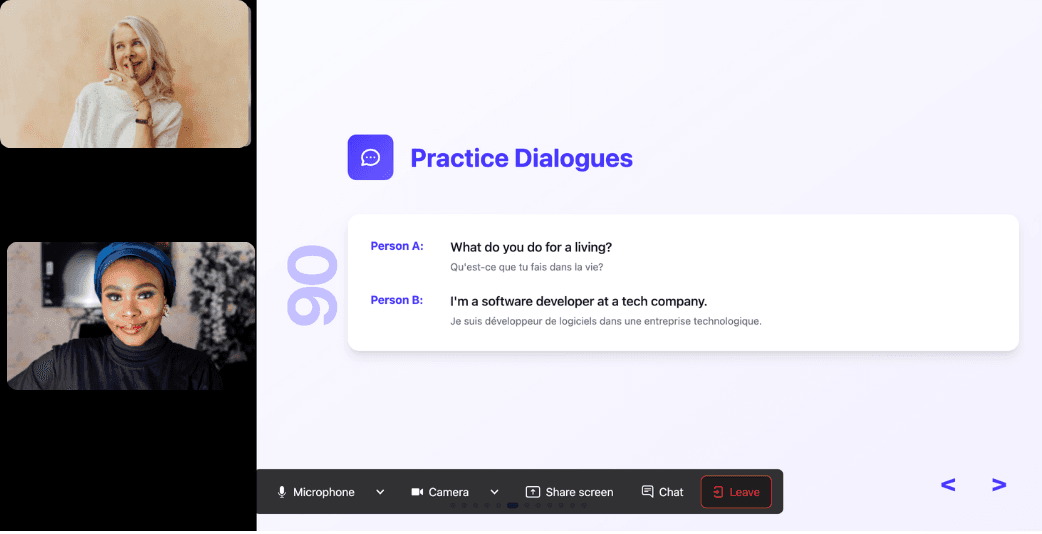
With 24/7 access at a fraction of the cost of private lessons, Kylian removes all the barriers that have kept you from mastering the language you’ve always wanted to learn.
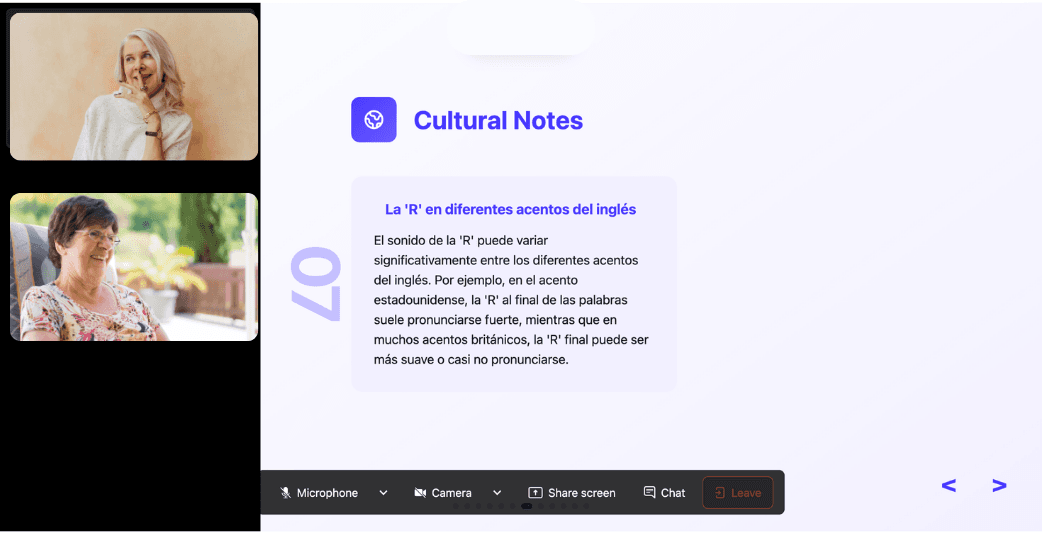
Similar Content You Might Want To Read

20 Best Countries to Live in 2025: Your Ultimate Guide
Finding your ideal destination to build a new life requires careful consideration of numerous factors. Whether you're seeking career advancement opportunities or creating a nurturing environment for your family, selecting the right country is a decision that warrants thorough research and reflection. From the culturally rich urban centers of Japan to the breathtaking natural landscapes of New Zealand, global opportunities abound for those with an adventurous spirit and desire for fresh beginnings. Yet with countless possibilities available, identifying the perfect location to call home presents a significant challenge.

15 Renowned Polyglots & Their Language Learning Wisdom
Ever wondered how some people master multiple languages with apparent ease? Like superheroes with linguistic superpowers, polyglots possess remarkable abilities that seem almost otherworldly. Yet unlike fictional characters, these language enthusiasts have real stories and practical advice worth exploring. The journey to multilingualism begins with curiosity—an intellectual spark that ignites a lifelong passion for languages. These extraordinary individuals weren't born speaking multiple tongues; they developed systematic approaches and mindsets that transformed language learning from daunting to achievable. Let's dive into the world of renowned polyglots and extract actionable wisdom from their experiences that can transform your own language learning journey.

How to Learn Chinese for Beginners: 9 Effective Steps
Learning Mandarin Chinese might seem daunting at first, but with the right approach, it becomes a rewarding journey. This comprehensive guide breaks down the process into manageable steps, helping you establish an effective learning routine regardless of your ultimate goal—whether it's basic conversation or professional fluency.

12 Cultural Differences in Nonverbal Communication
Communication transcends spoken language. Research by psychologist Albert Mehrabian reveals that nonverbal cues carry 55% of communicative weight, vocal tone contributes 38%, while words account for merely 7%. This data fundamentally challenges how we perceive effective communication, especially across cultural boundaries. The implications extend beyond academic curiosity. Misinterpreting nonverbal signals can derail business negotiations, strain diplomatic relations, or create uncomfortable social situations. Understanding these cultural variations isn't optional in our globalized economy—it's essential for anyone operating across cultural contexts. Anthropologist Michael Argyle documented over 700,000 distinct forms of body language and gestures across human cultures. This staggering diversity means identical gestures can convey opposite meanings depending on cultural context. The stakes are real: a well-intentioned gesture in one culture might be perceived as offensive in another.

Gomawo vs Kamsahamnida: Korean Thank You Expressions
Learning to express gratitude stands as a fundamental pillar when acquiring any language. Korean, with its nuanced system of formality and respect, offers multiple ways to say "thank you," each carrying distinct social implications. Two primary expressions—"gomawo" (고마워) and "kamsahamnida" (감사합니다)—reflect Korean society's hierarchical nature and complex social dynamics. This distinction proves critical for Korean language learners aiming for cultural fluency beyond mere vocabulary acquisition. The choice between these expressions reveals your understanding of social relationships and demonstrates respect appropriate to various contexts.

Master Korean Particles: Subject, Object, Location Guide
Korean particles function as the grammatical backbone that transforms disconnected words into coherent, meaningful sentences. Without these essential markers, Korean communication becomes ambiguous and structurally incomplete. Understanding particles represents the difference between basic vocabulary knowledge and functional Korean proficiency. The critical nature of particles becomes evident when examining Korean sentence structure. Unlike English, which relies heavily on word order to convey meaning, Korean employs particles to establish clear relationships between sentence elements. This fundamental difference explains why many Korean learners struggle initially—they approach particles with English grammatical expectations rather than recognizing their unique function within Korean syntax. Mastering particles requires systematic understanding of their specific roles, consistent application through practice, and recognition of how they interact within complete sentences. This comprehensive guide examines each particle category, provides practical usage examples, and addresses common learning challenges that impede particle mastery.